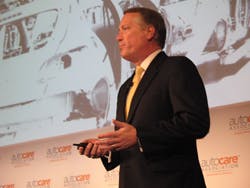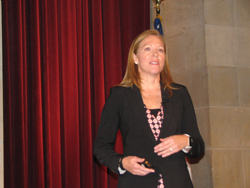Washington D.C. – Members of the auto care industry gathered in the U.S. Chamber of Commerce April 29 to present key metrics to legislators and regulators while drawing attention to ways the industry brings value to the U.S. economy.
To cement his point, Rassuli broke down the size of the market ($328 billion in annual sales), the scale of the transportation industry (265 million vehicles on the road today – including medium and heavy duty), and drew attention to the scope of the workforce (4.2 million employees in the sector, averaging $56,000 in wages per year). The industry comprises 6.6 percent of U.S. GDP via jobs and overall sales, he stated.
Auto Care Association President/CEO Kathleen Schmatz considered the forum a “coming out party to legislators andThe event featured presentations from Google, IHS Automotive, UPS, AAA, as well as opening remarks from NASCAR driver and team owner Michael Waltrip. Also presenting as keynote speaker was Assistant Secretary of Commerce for Industry & Analysis Marcus Jadotte of the U.S. Department of Commerce.
Jardotte said that the U.S. auto parts industry exported $81 billion in auto parts in 2014. OEMs in the U.S. exported 2.1 million vehicles, he said. Some 11.7 million jobs in the U.S. are supported by exports. U.S. Department of Commerce staff members work in 75 countries and focus on export opportunities.
Jardotte said two trade agreements being negotiated would help U.S. businesses increase their access to overseas markets. The Trans-Pacific Partnership (TPP) involves the U.S. and 11 other nations and would make it easier for U.S. companies to sell their products into some of the fastest growing economies in the world.
The Transatlantic Trade and Investment Partnership (T-TIP) is being negotiated between the U.S. and the European Union and would level the playing field for U.S. companies in European markets, he said.
“We need your help to increase fair trade for American industry,” Jardotte said. “Spread the word that T-TIP and TPP would open more markets for you and your products and have a positive impact on the U.S. economy.”
Light vehicle sales return
The mature markets of North America, Europe and Japan represent 71 percent of vehicles in operation today, but Seng expects that figure to decrease to 58 percent by 2021 due to growth in other regions. To meet global demand, OEMs are ushering in mega platforms, which use modular architecture with standardized practices to share production techniques worldwide. In 2013, 38 percent of the OEMs implemented standardized global platforms. By 2021, 58 percent of vehicles will be made on global platforms, he predicts.
OEMs are standardizing engine compartments, underbodies and passenger cockpits. This is important for the aftermarket because vehicle components can be shared from one country to another, Seng said. For example, Volkswagen is looking to achieve an 88 percent reduction in engine transmission variations.
Seng also noted that outside forces, such as consumer expectations and government regulations, are driving increases in vehicle complexity. Each OEM needs to increase fleet fuel efficiency by 5 percent per year to reach a goal of 86 mpg.
“This will usher in a new generation of gas and diesel engines for cleaner burns and cylinder shut down when running on the highway, and turbochargers for fuel efficiency and power,” Seng said. “Two technologies will be dominant. The stop start technology will be on 50 percent of global vehicles by 2021. It is at 16 percent today. GDI technology is at 26 percent today and will be on 66 percent by 2021.”
This is good news for the aftermarket because as vehicles become more complex, consumers will rely on independent repair shops and knowledgeable parts distributors when fixing their cars.
With regard to service, Pillartz notes that consumers frequently turn to the Internet to validate what they are being told in the shops when a professional technician is consulted about a repair.
Among all ages, 30 percent of drivers research how to perform repairs themselves before taking a vehicle to a professional; and 33 percent of drivers conduct research after getting the recommended service from a technician. Among ages 18-44, those figures increase substantially - 47 percent of drivers research how to do the repair themselves; 50 percent of drivers research after getting service recommendations.
These are trends to monitor, as more and more consumers educate themselves about the repair process.
Subscribe to Aftermarket Business World and receive articles like this every month….absolutely free. Click here.





